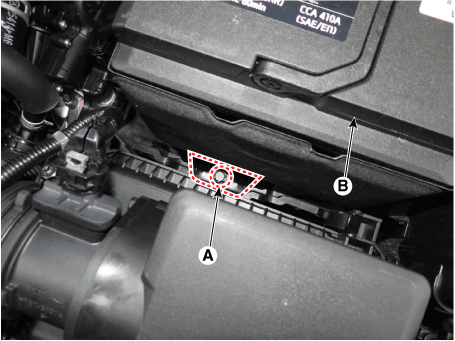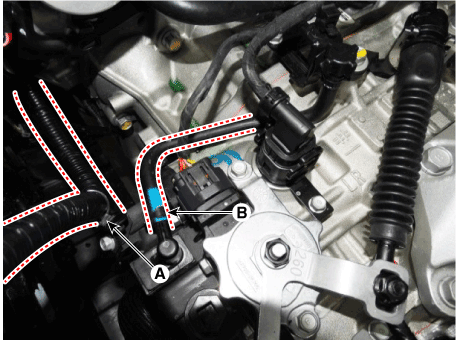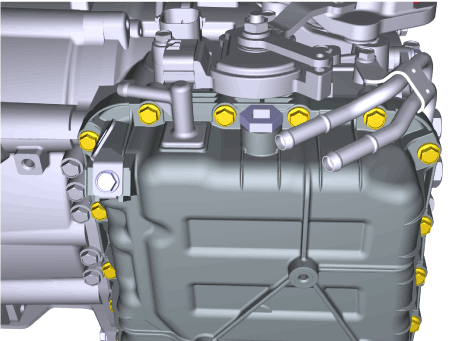Hyundai Venue: Automatic Transaxle Control System / Input Speed Sensor. Repair procedures
| • |
When Diagnostic Trouble Codes (DTC) is on, perform the following
procedure to replace it.
|
| • |
Automatic transaxle is composed of delicate components. Be careful
not to cause any damage on the component in the course of assembly
and disassembly.
|
| • |
Maintain clean condition so that foreign substance does not
get into the automatic transaxle.
|
| • |
Use a coated apron, latex gloves, and stainless tray to prevent
foreign substance from getting into the transaxle.
|
| • |
Automatic transaxle fluid (ATF) can be reused. Collect it using
a clean 10-liter beaker.
|
|
| 1. |
Turn ignition switch OFF and disconnect the negative (-) battery cable.
|
| 2. |
Remove the air cleaner and air duct.
| (1) |
Remove the air duct (A).

|
| (2) |
Disconnect the breather hose (B) and air intake hose (C).
|
| (3) |
Remove the air cleaner assembly (D).
|
Tightening torque :
Hose clamp bolt (C):
2.9 - 4.9 N.m (0.3 - 0.5 kgf.m, 2.1 - 3.6 lb-ft)
Air cleaner assembly bolts (D) :
3.9 - 5.9 N.m (0.4 - 0.6 kgf.m, 2.9 - 4.3 Ib-ft)
|

|
|
| 3. |
Remove the battery (+) terminal (A).
|
Tightening torque :
7.8 - 9.8 N.m (0.8 - 1.0 kgf.m, 5.8 - 7.2 lb-ft)
|

|
| 4. |
Remove the battery mounting bracket (A) and the battery (B).
|
Tightening torque :
9.0 - 14.0 N.m (0.9 - 1.4 kgf.m, 6.6 - 10.3 Ib-ft)
|

|
| 5. |
Remove the ECM.
| (1) |
Disconnect the ECM connector (A).
|
| (2) |
Loosen the mounting bolts (B) and then removing the ECM bracket
assembly.
|
|
Tightening torque :
9.8 - 11.8 N.m (1.0 - 1.2 kgf.m, 7.2 - 8.7 lb-ft)
|

|
| 6. |
Remove the battery tray.
| (1) |
Loosen the mounting bolt (A) and then removing the battery (+)
terminal bracket.
|
Tightening torque :
8.0 - 10.0 N.m (0.8 - 1.0 kgf.m, 5.9 - 7.4 lb-ft)
|

|
| (2) |
Loosen the bolts and then removing the battery tray (A).
|
Tightening torque :
8.8 - 13.7 N.m (0.9 - 1.4 kgf.m, 6.5 - 10.1 Ib-ft)
|

|
|
| 7. |
Remove the drain plug (A) and drain the ATF totally and then reinstall
the drain plug.

| •
|
Replace the gasket before reinstalling the drain plug.
|
| •
|
After the installation, start the engine and then check
if there are any leakages from the drain plug.
|
|
|
| 8. |
Remove the wiring mounting clip (A).
|
| 9. |
Disconnect the air breather hose (B) from the valve body cover.
|
Tightening torque :
9.8 - 11.8 N.m (1.0 - 1.2 kgf.m, 7.2 - 8.7 lb-ft)
|

|
| 10. |
Disconnect the hose (A) after removing the automatic transaxle fluid
cooler hose clamp.

| •
|
Carefully install the clamp not to damage the hose.
|
| •
|
Install the clamp in a correct direction not to be interfered
with other parts.
|
| •
|
After the installation, start the engine and then check
if there are any leakages from the hose.
|
|
|
| 11. |
Remove the valve body cover (A).
|
Tightening torque :
11.8 - 13.7 N.m (1.2 - 1.4 kgf.m, 8.7 - 10.1 lb-ft)
|


| •
|
Replace the gasket (A) before reinstalling the valve
body cover.

|
| •
|
After the installation, start the engine and then check
if there are any leakages from the valve body cover.
|
|
|
| 12. |
Disconnect the oil temperature sensor and solenoid valve connector (A)
from the valve body.
|
Tightening torque :
9.8 - 11.8 N.m (1.0 - 1.2 kgf.m, 7.2 - 8.7 lb-ft)
|

| •
|
Check for the looseness, poor connection, bending, corrosion,
contamination, deterioration, or damage before reinstalling
the solenoid valve connector.
|
|
|
| 13. |
Remove the valve body assembly (A).
|
Tightening torque :
9.8 - 11.8 N.m (1.0 - 1.2 kgf.m, 7.2 - 8.7 lb-ft)
|

|
| 14. |
Disconnect the input & output speed sensor connector (A).

|
| 15. |
Remove the input & output speed sensor (A) after removing the bolts
(2ea).
|
Tightening torque :
9.8 - 11.8 N.m (1.0 - 1.2 kgf.m, 7.2 - 8.7 lb-ft)
|

|
| 1. |
To install, reverse the removal procedure.
|
| 2. |
Check fluid level after filling the automatic transaxle with fluid.
(Refer to Automatic Transaxle Syatem - "Automatic Transaxle Fluid (ATF)")
| 1) |
After ATF level check or exchange, be sure to remove
residual ATF on transaxle case.
(Be especially sure to remove residual ATF between automatic
transaxle case and valve body cover)
|
| 2) |
After installing the valve body cover, make sure to
check the oil leakage at the connection area with the
engine ON.
|
|
|
Specifications
▷ Type : Hall effect sensor
▷ Specifications
Items
Specifications
Operation condition [°C(°F)]
(-40 to 150) -40 to 302
Output voltage(V)
High
1...
Description
The output speed sensor is a vital unit that measures the rate of rotation of
the transaxle's turbine shaft and output shaft, and delivers the readings to
the TCM...
Other information:
..
Removal
1.
Release the residual pressure in fuel line.
(Refer to Fuel Delivery System - "Release Residual Pressure in Fuel
Line")
2.
Turn the ignition switch OFF and disconnect the battery negative (-)
cable...
Categories

This gauge indicates the approximate amount of fuel remaining in the fuel tank.
Information
The fuel tank capacity is given in chapter 2.
The fuel gauge is supplemented by a low fuel warning light, which will
illuminate when the fuel tank is nearly empty.
On inclines or curves, the fuel gauge pointer may fluctuate or the low
fuel warning light may come on earlier than usual due to the movement of fuel
in the tank.
read more
 Input Speed Sensor. Specifications
Input Speed Sensor. Specifications Output Speed Sensor. Description and operation
Output Speed Sensor. Description and operation























